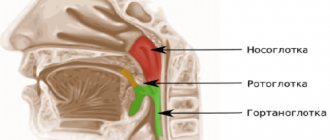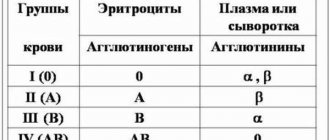What is the SCC tumor marker and for what reasons does its concentration change?
The SCC tumor marker is a tumor-associated antigen of squamous cell carcinomas, which has different locations in the body.
This protein substance was first discovered in 1977 and was found mainly in the epithelium of the cervix. But it is also produced on the walls of the neck and head. In the literature it is known under the following names: Squamous cell carcinoma antigen (SCCA), Tumor Associated Antigen4 (TA-4), SCC-AG and SCCA, Squamous cell carcinoma marker and others.
The specificity of the SCC tumor marker is that it consists of two isoforms:
- SCC1 is produced by healthy and pathological cells and can be increased in infectious, viral diseases and tumors.
- SCC2 is produced exclusively by carcinoma cells, and an increase in its level indicates the development of a malignant disease. The higher the concentration, the higher the stage with the risk of metastasis.
This substance is found in some quantities in human saliva and sweat. Therefore, during the examination, it is extremely important to prevent one or the other from entering the blood.
GENERAL BLOOD ANALYSIS
- the most common type of test, which is a diagnostic study that allows you to assess the number of red blood cells and their sedimentation rate, hemoglobin content, the quantitative level of immune cells - leukocytes, as well as the necessary blood clotting factors - platelets. These indicators are considered basic and are determined by examining a blood smear under a microscope.
For a complete clinical blood test, a small amount is sufficient, which can be obtained from a finger by pricking the skin. The injection is applied with a special scarifier. Blood sampling is carried out in the morning on an empty stomach. Taking any medications, smoking, drinking alcohol and coffee can distort the results of laboratory tests.
A general blood test is widely used in examinations by many doctors to diagnose erythremia, anemia, immunodeficiency, the presence of viruses and inflammatory processes in the human body, and to study the condition of vascular cells. Some diseases, in the presence of other symptoms, are confirmed with almost 100% probability by a general blood test.
When to do an analysis and how to prepare for it
The SCC tumor marker, depending on its concentration in the blood, allows one to determine not only the presence or absence of a tumor, but also the stage of the disease and the progress of tumor growth.
In addition, it happens that the result of the study is not positive. It happens when the amount of a substance increases during diseases such as lichen, psoriasis, some dermatological diseases, ARVI, pneumonia, tuberculosis of any form and severity. This suggests that testing for this marker alone is not enough to diagnose cancer.
The main indications for the examination are:
| Assessing the adequacy of treatment and early prevention of cancer. |
| During treatment of patients with elevated levels of SCC protein. |
| Control of tumor development in patients diagnosed with cancer. |
| Prediction of the likelihood of metastasis. |
| Control of relapse after treatment. |
In the first few days after removal of the tumor or suppression of its development, the SCC tumor marker level will be within acceptable limits. Therefore, a repeat analysis is necessary after a couple of months. In case of negative reaction, repeat every 6 months to control relapse.
Preparation for analysis in accordance with general clinical requirements, similar to those required for patients donating blood for biochemistry.
So, 8-12 hours before the analysis, you must stop consuming any food, alcohol, or tobacco. Only drinking water without gas is allowed. Tea, coffee, juice and any other drinks are also not recommended. In consultation with the treating doctor, it is advisable to stop taking medications. If this is not possible, then you must inform your doctor about taking medications.
On the eve of the examination, it is worth excluding physical activity and any types of diagnostics, in particular instrumental ones. Massage is also contraindicated.
All women must take into account the day of their menstrual cycle. In this case, a specialist will help you choose the right day for analysis, when the concentration of hormones is optimal. As a result, the normal SCC tumor marker in women will be shown reliably.
Since this protein compound is found not only in the blood, but also in other body fluids, it is very important to take care of clean and dry skin before the analysis.
The best time to collect material is considered to be in the morning from 8 to 12 o'clock.
HORMONAL BLOOD TESTS
Very rarely carried out as planned. Typically, doctors recommend such tests only if they suspect the existence of any pathology of the endocrine system. Such an analysis is often necessary to clarify the diagnosis. Hormones have a complex systemic effect on the body, thanks to them the regulation of metabolism of all types in the human body (water-salt, lipid, carbohydrate, protein). Hormone blood test results may show hyperfunction, hypofunction, or dysfunction of the glands.
When taking hormonal blood tests, the patient should take into account a number of factors that influence the results:
- It is important to exclude increased physical activity on the eve of the study.
- A day or two before the test, refrain from drinking alcohol.
- Do not smoke for at least 2 hours before the test
- The test for hormones should be carried out with complete calm in order to exclude changes in hormonal levels.
- If you are using any medications, you must notify your doctor.
At the medical office, you can donate blood for any type of test as prescribed by our doctor or a doctor from another medical institution. Blood tests in Voronezh are carried out in a specially equipped laboratory by our partners - New Medical Technologies Center for Laboratory Diagnostics
What are the features and advantages of conducting analysis?
The result of a blood serum examination clearly shows not only the growth, but also the reason why the SCC tumor marker increases, the stage and progression of the disease.
The peculiarity is that it is prescribed when a previous examination showed the presence of possible oncology. This test is not prescribed as a single diagnostic option and method for detecting a tumor.
Its advantage is the ability to determine the size of the tumor, the exact location, the rate of progression of the compaction, the presence/absence of metastases, their degree of spread, and also predict the risk of the metastatic process.
The SCC tumor marker analysis very accurately shows minimal fluctuations in concentration, so it can be used to easily monitor the quality of patient treatment. For the same reason, you can effectively adjust the treatment program, the amount of drugs administered, and so on.
Along with the advantages, there are also disadvantages, in particular, low specificity. The result of the analysis can give a positive reaction even in the absence of any compactions against the background of an inflammatory disease, for example.
Another significant drawback is the low sensitivity of the marker, which makes it impossible to detect a tumor at an early stage.
Top mandatory annual analyzes
To monitor your own health, experts advise taking the following tests every year:
- General blood analysis . The material for research is taken from the finger. The analysis shows the presence or absence of blood diseases, anemia, and inflammatory processes. Based on the data obtained, an experienced doctor can draw a conclusion about the state of the human immune system.
- General clinical urine analysis . This is the main study to assess the condition of the genitourinary system. The presence of leukocytes in the urine will indicate inflammation, and based on the level of this indicator, a specialist can determine which organ was affected and suggest the development of cystitis, urethritis, pyelonephritis and other diseases. In addition, a urine test may indicate the development of diabetes.
- Blood chemistry . To conduct the study, blood is taken from a vein. Having studied the results of this analysis, a specialist can evaluate the functioning of many organs and systems of the body: kidneys, liver, bile ducts. Biochemistry well reflects the smoothness of metabolic processes in the body - one of the main indicators of good health.
- A glycated hemoglobin blood test is needed to assess blood sugar levels and their fluctuations over the past 4-6 weeks.
- Blood test for HIV, hepatitis B and syphilis.
- Analysis for STIs: ureaplasmosis, trichomoniasis, mycoplasmosis and others.
- Test for thyroid hormones. For the study, blood is taken from a vein and the levels of free thyroxine and thyroid-stimulating hormone are determined. Such diagnostics are especially important for residents of large cities, where severe natural iodine deficiency is observed.
In addition, an annual medical examination involves undergoing the following studies and examinations by specialists:
- electrocardiogram is a highly informative method for studying the functioning of the heart;
- fluorography – in the early stages allows one to suspect diseases and tumors of the tissues covering the lungs;
- for women – examination by a gynecologist, for men – by a urologist;
- An annual examination by an ophthalmologist will help prevent the development of glaucoma and cataracts;
- Sanitation of the oral cavity by a dentist will help maintain dental health for as long as possible.
What method is used to analyze and interpret the results?
CLIA (Caris Molecular Intelligence) is a molecular test of a tumor sample. This method allows you to select a treatment program as individually as possible, taking into account the “age” of the tumor and many other features of the course of the disease and the condition of the patient.
Decoding of the SCC tumor marker is carried out exclusively by the doctor of the laboratory in which the analysis is performed. The results are entered on a special sheet, which is attached to other certificates.
Normally, the amount of the substance in both men and women should not exceed the range of 2.0-2.5 ng/l. If this amount increases to 10 ng/l, this indicates that a benign neoplasm is present in the body.
If the SCC tumor marker level is above 10 ng/l, this indicates possible cancer of the cervix and other organs. And the higher this indicator, the older and more progressive the process.
Indicators may remain within normal limits immediately after recovery. In cases where the pathology does not synthesize these tumor markers, the treatment is chosen correctly and is effective.
If an increase in the concentration of substances is detected, it is necessary to undergo additional examination:
- Donate blood again.
- Biopsy.
- Cytology and histology of the sample.
- MRI, ultrasound, CT.
Persons at risk (genetic predisposition, previous suspicion of cancer, diagnosed benign tumors, age over 50 years) must undergo preventive diagnostics annually in a medical institution.
Mandatory annual tests for women
The female body is designed in such a way that many serious gynecological diseases in the early stages are completely asymptomatic. For this reason, women are recommended not only to visit a gynecologist annually, but also to undergo a number of mandatory tests:
- Flora smear : a study showing the quantitative and qualitative composition of the microflora of the vagina, cervix and urethra. It is the main technique that detects the presence of pathogenic agents in scraping the surface of these areas. It is the deviations in the flora smear that serve as the basis for prescribing additional high-precision tests.
- Bacterial culture determines the presence and type of causative agent of a bacterial infection. In addition, the analysis shows to which antibacterial substance the pathogenic agent detected in the analysis is sensitive.
- PCR diagnostics detects the presence of STIs: ureaplasmosis, genital herpes, chlamydia and others.
- A blood test for TORCH infection allows you to determine antibodies to the rubella virus, cytomegalovirus, toxoplasmosis and herpes simplex virus.
The state of health in the future largely depends on what measures a person takes to preserve it today. Therefore, you should not ignore the recommendations of doctors, but on your own initiative undergo a full range of diagnostic studies that describe a full picture of the coordinated work of all organs and systems of the body.
The introduction of this contraceptive is carried out in the last days of the menstrual cycle or in the first days after it. After an abortion or childbirth without complications, the procedure is carried out immediately after the operation or after 5-6 weeks. After a caesarean section, the IUD can be installed only after 10-12 weeks.
As a rule, the installation is performed without anesthesia. Of course, each type of spiral has its own characteristics, but the basic principle is the same. The woman is placed on a gynecological chair, the external genital organs are treated with an antiseptic, and then the cervix. After this, the neck is fixed with bullet forceps and straightened. A conductor with a closed contraceptive is inserted into the cervical canal and moves into the uterine cavity to the required distance. Then, by moving the piston, the spiral opens and is located inside. Threads - tendrils are placed in the vagina and cut to the desired length. The procedure is virtually painless and takes about 5-7 minutes.
If you find an error, please select a piece of text and press Ctrl+Enter











